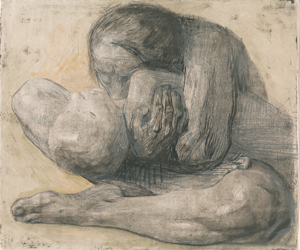Private viewing
By Brooke E. O’Neill, AM’04
Image courtesy Smart Museum of Art
 Käthe Kollwitz’s 1903 etching Woman with a Dead Child was meant to be viewed in private.
Käthe Kollwitz’s 1903 etching Woman with a Dead Child was meant to be viewed in private.Although the late 19th-century Parisian art world was dominated by Monet, Renoir, and other Impressionists, many collectors inhabited a darker, more private realm. Carefully guarded in albums and drawers, their prints, drawings, and small sculptures were kept out of public view, meant to be contemplated in solitude. The subject matter was often melancholy, even violent. More than 100 such pieces are on display through June 13 in The Darker Side of Light: Arts of Privacy, 1850–1900, a visiting exhibition at the Smart Museum of Art. Curated by the National Gallery of Art’s head of old master prints, Peter Parshall, AM’67, PhD’74, the exhibit groups works into broad themes such as “abjection,” “death,” and “obsession.” A Renaissance scholar, Parshall conceived the exhibition idea more than a decade ago while sorting through the roughly 40,000 works under his supervision. “The way I sometimes present this exhibition,” he says, “is to say that it is the not-Impressionism exhibition.”
Learning curve: When I came to the National Gallery [in 1999], I was put in charge of a collection that goes from the 15th century on; I became responsible for everything up to 1900. So, essentially, I added three centuries to my usual territory, and I’ve spent the last ten years venturing forward.
Under the surface: Impressionism is, not inappropriately, seen as an art that concerned itself with surface impression, with the interaction of light on surfaces, and also with the outside world, particularly in and around Paris. … What the exhibition takes on is, in a sense, everything else. What goes on inside the mind—interiority—and what accounts for it: in short, the human condition.
Not for public display: The 19th century was a period when books were being written about what was appropriate to put in the sitting room and in the entry hall: you put landscapes here; you put portraits there. You didn’t put complicated images up because those needed more attention.
Must-see: Perhaps the most wrenching of all of the pieces, one I’ve placed in the category of “abjection,” is an elaborately worked proof state of a print by Käthe Kollwitz, Woman with a Dead Child. It’s an extremely unsettling image, very blunt, almost animal-like in its character, and something that you cannot but stop in front of and feel deeply moved by.
Less is more: The sparing use of explanatory text [in the exhibit] is an encouragement for people to get involved with the individual images and really try to take them apart, figure out what’s going on there. … It has been my experience watching people go through the exhibition that they linger. They dwell on the work. They look rather than read, and they come out of it with a different sense of what the late 19th century was about.
Rated PG-13: There are only, let’s say, one or two things that I think I would walk past quickly with a child.
